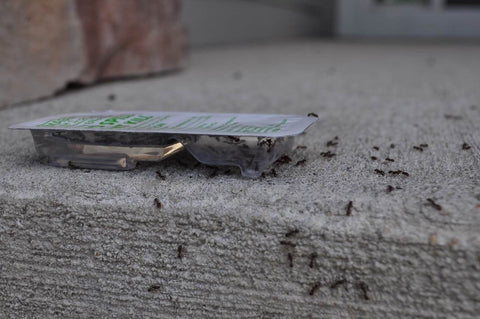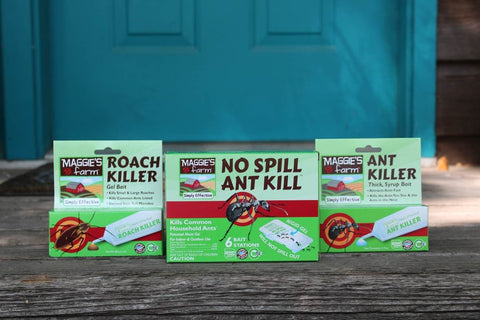Ants march into homes in spring looking for something to eat. That’s why ant baits are a great solution. They control the ants you see and eliminate the hidden colony. Before you start ant baiting, there are a few things you’ll want to do to ensure your baiting efforts are effective. Check out seven tips to prepare for ant baiting this spring.
Why Do Ants Invade in Spring?

After spending winter underground, ants emerge in spring ready to eat. Foraging ants head out in search of food, moisture, and shelter. It won’t be long before they head into your home. Once these pests find a food source, they release pheromones alerting other ants to their location. This leads to ants continuously invading your home.
Common Ant Species That Invade in Spring
Check out a few ant species that are likely to bug you this spring.
Odorous House Ants

These ants are usually the first pests you’ll see every spring, measuring up to about one-eighth of an inch. They are smaller and darker than fire ants (usually dark brown to black), and they have a unique odor that smells like rotted coconuts when squished. Odorous house ants prefer sugars and dead insects to eat.
Pavement Ants

Pavement ants are a bit smaller than Odorous House ants (about one-tenth of an inch) and are brownish-black in color. They typically build their nests near driveways and patios, and they love a wide variety of foods, including sweets, meat, grease, and other insects. Pavement ants bite and even sting if provoked, so watch out!
Ghost Ants

Ghost ants are also known as sugar ants, due to their love for sweets. They are tiny, even for ants, and are known for their signature dark head and pale, see-through abdomen and legs (about one-half to three-quarters of an inch at most). These ants are a tropical species, typically found in warm climates in greenhouses and structures able to provide enough warmth.
Pharaoh Ants

At some point, someone mistakenly named these ants “Pharaoh,” thinking they were the very ant species that plagued Egypt. Another very tiny ant, measuring about 1/16”, they are native to Africa, and currently found throughout the United States. These ants are usually of a pale color (varying from yellowish to reddish), with a dark to black abdomen.
All ant species have their own unique characteristics, but when it comes to food, all ants are the same. They’re hungry and determined to find it! Hence, one of their favorite places to spend time indoors is the kitchen.

What Can I Do to Get Ready for Spring Ants?
Here are the main things you can do to prepare.
1. Turn Over Your Mulch

Hopefully, before it snowed last fall, you thoroughly turned over any mulch in your yard with a rake. If not, put that on your list for this coming fall. Repeat in the spring. This is probably the most important thing you can do, as ants love to burrow and build in rotting mulch piles. The worst thing you can do is to just keep piling fresh, new mulch on top of the previous years.
2. Keep Your Yard Clean

Thoroughly clean up your yard in fall and spring. You want to get rid of potential harboring sites where ants could build their colony. Be sure to get rid of all:
- Man-made clutter including trash
- Piles of grass clippings and leaves
- Brush
3. Trim Your Lawn & Vegetation

Keep your grass cut short for as long as weather permits. Keep trees, hedges, bushes, and plants well-trimmed. You don’t want them touching the side of your home. This will help keep ants at bay so they can’t enter your home by means of overgrown foliage. This will also prevent them from bypassing the bait you’ll be placing.
4. Remove or Spray Landscape Timbers

Woodpiles are another ideal spot for ants to make themselves at home. Remove timbers and woodpiles that aren’t being used. Store firewood away from your house and off the ground. You can also spray woodpiles with an insecticide.
5. Seal Cracks

Caulk all cracks and gaps in your home’s foundation. Check for holes near windows and doors. Examine the area where cables, utility lines, and pipes enter your house for gaps too. It’s also important to repair damaged window and door screens.
6. Eliminate Moisture

Moisture is an attractant of ants and other pests. Minimizing moisture in your yard and home can help prevent ants.
- Make sure there’s a dry barrier around the structure’s foundation and outside walls.
- Ensure all outdoor faucets are tightly closed.
- Repair or replace dripping rain gutters.
- Move damp mulch and rotting wood away from the foundation.
- Don’t let sprinklers spray the side of your house.
- Repair any water leaks inside and outside your home.
7. Remove Food Sources

Ants will eat whatever food they can find. These other food sources can distract ants from bait. Removing potential food sources is important to make your ant baiting efforts successful.
- Clean up crumbs and spills.
- Never leave food out on the counter or pet food on the kitchen floor.
- Keep food packages closed or store items in air-tight containers.
- Place garbage in sealed trash bags. Take the trash out frequently.
- Eliminate aphids in your garden. Ants feed on the sweet honeydew aphids excrete. Not only will you remove a food source, you’re also protecting your plants.
How to Use an Ant Bait

After taking the above steps, you’ll be ready to place the bait.
- Strategically place bait stations or bait placements next to ant trails. You can also place them under and near sinks and tubs, underneath appliances, in corners, along floorboards, and near other areas where ants may access your home.
- Don’t place bait near areas you have sprayed with a repellent insecticide. This will deter the ants from eating the bait.
- After ants feed on the bait, they will consume it and take it back to their colonies to share. This will help to kill off the rest of the ants.
- Be patient. Bait kills ants within a few days after eating it. However, it will take time for the entire colony to consume the bait. The larger the colony, the longer it will take to eliminate an infestation.
How to Choose an Ant Bait

Our No Spill Ant Kill and Ant Killer Bait are sugar-based baits that can work year-round. Some ants are looking for protein in spring. You’ll want to use a protein-based bait like our Roach Killer Gel Bait. You can test which bait will work better by placing a drop of peanut butter and honey on an index card. If the ants head to the peanut butter, they are looking for protein. If they feed on the honey, they want sugar. This will help you choose which bait will work best.
For baits to work effectively, you need to set yourself up for success. If you're dealing with an ant problem, we're here to help! Check out our Maggie's Farm Simply Effective™ Pest Control products for a more environmentally and family-friendly solution.
